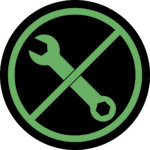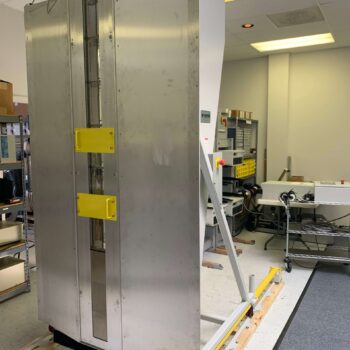Our customer approached us with a desire to UV cure hard optical coatings on vertically-oriented polycarbonate sheets suspended from an overhead conveyor. We partnered and consulted with them throughout the development of their existing flow-coat pilot line. After the pilot line proved feasibility, our customer approached us to provide an industrialized solution for their new full-production line. We designed, built, and delivered a robust, well-engineered, and easily maintained UV system featuring pair of vertical UV curing towers.
Design Story

Identify
Through working with our customer throughout the development of their pilot line, we were able to determine a list of their requirements:
- They needed to be able to cure coatings applied to both sides of vertically-oriented polycarbonate sheets up to 60” tall and varying thicknesses.
- The sheets couldn’t blow around in the narrow cure tunnel, so we needed to have a quartz window to redirect the irradiator cooling air.
- Minimize downtime for routine maintenance, as the UV curing system is critical to their production cycle.
- They needed to cure as close as possible to the top of the sheet as possible to reduce scrap (the uncured portion at the top is cut off as scrap in a later process).
- Maximize throughput without sacrificing part quality (specifically too much heat causes bowing).

Assess
We helped our customer to choose between an arc lamp or microwave-powered lamp, as well as helping with the specific bulb/reflector combination. After this, we continued to consult with the customer during the development of their pilot line, which was very helpful when they approached us to provide the production system.

Design
We completed a thorough detail design of the system which employed two opposing towers, each supporting up to 8 vertically oriented Heraeus 10” microwave LH10 lamps.
We employed a quartz window design and associated air handling system to keep the polycarbonate sheets protected from the turbulent airflow required to cool the lamps. 84” of quartz glass are secured in an aluminum frame to create a quartz window panel that mounts flush and is easily removed for cleaning and service.
In addition to this, we considered our design pillars:

Smooth Transition
The design was modeled after the customer’s pilot line to capitalize on the process validation already performed by the customer. Enhancements to the design were made while still maintaining the core physical architecture in order to ensure seamless process integration at on the new production line.

Low Maintenance
The towers are mounted on floor tracks to allow for easy removal of the tower from the tunnel in order to gain access to the lamps for regular maintenance. Access to the front face of the lamps for regular service is quick and easy, requiring only general-purpose hand tools.
To keep production downtime to a minimum in situations where more intensive irradiator service is necessary, lamp removal is made simple with quick release hoses and custom irradiator mounting brackets and aligning pins.

Process Intelligence
The Heraeus Light Hammer 10 Mark II systems selected for this project are compatible with Heraeus’ Advanced Integrated Monitoring System (AIMS) hardware and software. This allows the customer to leverage sensor data and analytics for predictive maintenance, reduce operating costs and downtime, and extend the life of key components, should they choose to in the future.
The control system provides simple remote control of each UV tower in either dual (simultaneous) or discrete control modes, integrates tower positioning interlocks, and offers an external line controller override.

Design Flexibility
We created the system with provisions for installing additional lamps below the current array in order to accommodate 80” tall sheets in the future. Additionally, to maintain the exact distance needed for a focused exposure at different sheet thicknesses, we created a fine-tunable positioning mechanism to precisely set the tower positions.

Integrate
We quickly delivered a complete, turn-key solution for our customer with system integration, assembly, test, and check-out performed in our System Integration Lab (SIL) ahead of shipment to the customer’s new facility. In-house testing included functional checks on the power distribution systems, interlocks, and irradiation systems as well as the high volume air handling package, which moves nearly 4,000cfm to keep the lamps cool despite the restrictions imposed by the quartz window.

Support
Like we do with all our systems, we provided a complete installation, operation, and maintenance manual package. These manuals, drawings, and schematics were generated specifically for this custom application in order to equip the customer with the knowledge and information they need to successfully implement their new UV system. We also offered on-site installation support and training to get the customer up to speed quickly with reduced risk.




